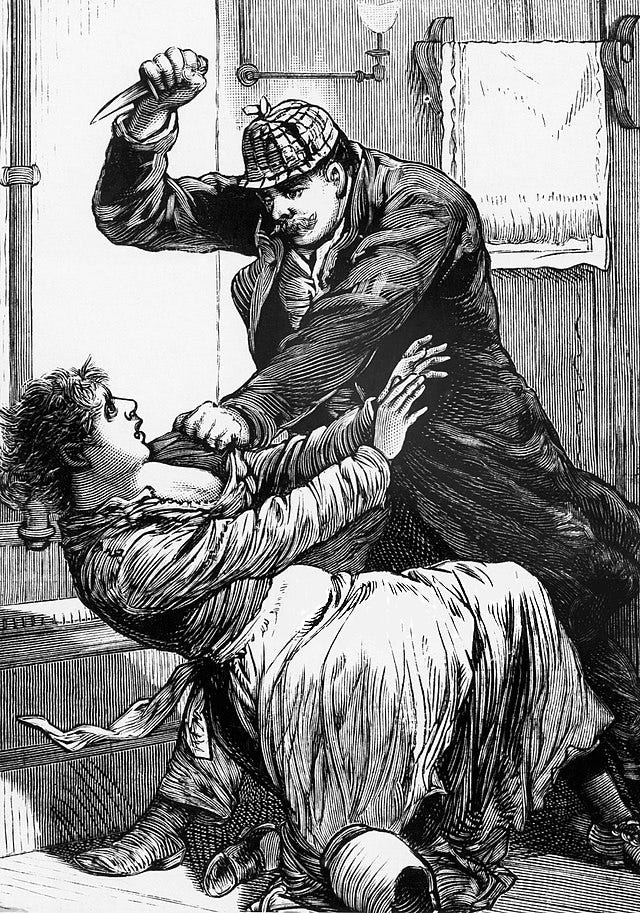True Crime Girl
In the past month, one of the most infamous killers of the 19th century has finally been identified. While this is major news on its own, it also sparks important questions: How long can DNA truly last? Should it be considered valid evidence? And what role does public genealogy play in solving mysteries?
According to new reporting, the infamous London killer Jack The Ripper, known for murdering five prostitutes, has recently been identified as Polish immigrant and barber Aaron Kosminski.
The Ripper’s Story
Between August 7 and September 10, 1888, a series of five murders occurred within a few miles of each other in London's East End, spanning Whitechapel, Spitalfields, Aldgate, and other nearby areas.
While some enjoyed London’s East End, others saw it in a much darker light. At the time, the area was home to many Jewish and Russian immigrants seeking new opportunities and starting businesses. However, it also gained a reputation for violence and crime. Prostitution, though not entirely legal, was widespread and generally tolerated unless it caused public disturbances. As a result, the East End was filled with brothels and low-rent lodging houses.
As a result, the murder of a "working" woman was rarely reported, as violence against prostitutes was an unfortunate reality in the area, sometimes even leading to death. However, the killings in 1888 stood apart. These crimes were far more sinister, as many of the victims were brutally butchered, suggesting the work of a psychopath.
Beyond the gruesome murders, the killer also taunted the Metropolitan Police by sending letters under the alias, "Whitechapel Butcher." In these messages, he boasted about his past killings and hinted at more to come. Due to the brutal nature of his attacks, he soon became infamously known as Jack the Ripper.
When the killings suddenly stopped, local residents and those following the investigation were left desperate for answers about the killer's identity and motives. This craving for closure, combined with the lack of concrete information, widespread misinformation, and numerous false testimonies over the years, gave rise to an entire industry of books, TV shows, movies, and historical tours.
Despite countless investigations over more than 144 years—conducted by both police departments and private individuals—his true identity was never uncovered.
Over the years, many theories have emerged about Jack the Ripper's identity. Some of the most popular suspects include the famous Victorian painter Walter Sickert, a Polish immigrant…
and even Prince Albert Victor, the grandson of Queen Victoria.
In fact, since 1888, more than 100 suspects have been named, which largely contributes to why Jack the Ripper has become such a worldwide phenomenon.
In recent years, many have suspected Kosminski, but the evidence supporting these claims has often been debunked. However, recent forensic analysis of a stained silk shawl found next to the body of the Ripper's fourth victim, Catherine Eddowes, has provided new insight. The shawl, it turns out, contains what is believed to be the blood and semen of Kosminski.
As mentioned earlier, Kosminski had been a suspect before, but this is the first time that DNA evidence has actually supported the claim.
The first genetic tests on the shawl were conducted several years ago by Jari Louhelainen, a biochemist at Liverpool John Moores University in the UK. According to Science.org, Louhelainen wanted to wait for the initial hype to settle before submitting the results. Author Russell Edwards, who purchased the shawl in 2007 and provided it to Louhelainen, later used the unpublished test results to identify Kosminski as the murderer in his 2014 book Naming Jack the Ripper.
However, geneticists initially dismissed the claims, citing technical issues with the analysis of the genetic samples.
The most recent findings, published in the Journal of Forensic Sciences, address all previous discrepancies. Both Louhelainen and Edwards claim that this new research represents "the most systematic and advanced genetic analysis to date regarding the Jack the Ripper murders." In the paper, they detail the process of extracting and analyzing DNA from the shawl, comparing the fragments to samples from living relatives, and ultimately obtaining a match.
From this data, they also determined that the killer had brown eyes and brown hair, traits that were very rare in London at the time and uniquely matched Kosminski. This also aligned with an eyewitness testimony.
Despite this evidence, critics continue to question the reliability and credibility of the data.
So why does this matter? Recently, I wrote about the JonBenet Ramsey case and how her family has spent nearly two decades searching for her killer. Her father continues to question why public genealogy can't be used to help solve the case. The Jack the Ripper investigation proves that it can—with DNA from an extremely distant relative dating back 144 years, Louhelainen and Edwards were able to identify one of history's most infamous killers using a single piece of evidence. So with multiple pieces of evidence and access to a vast genealogy database, why hasn’t the same approach been applied to the Ramsey case—or countless others?
Bryan Kohberger Update
Last week saw a flurry of activity in the case of Bryan Kohberger, the accused in the murder of four Idaho college students in November of 2022.
First, the prosecution filed evidence of purchases made on Kohberger’s Amazon account purporting to show that Kohberger purchased a K-Bar knife, similar to the one believed to be used in the murders, eight months before the crime.
The knife apparently came with a sheath that matches the one found at the crime scene, and which bore the single sample of touch DNA used as part of identifying Kohberger (yet another use of genealogical DNA in solving a crime). A knife sharpener was also purchased.
Additional filings apparently show that the same Amazon account was used in the weeks after the murders to search for a similar knife and sheath. Which begs the questions: Was this to be a replacement for the murder weapon? And if so — is it possible that Kohberger, if he is indeed the perpetrator, planned to kill again? And does his computer show evidence of other victims being cyber-stalked?
The prosecution also filed as evidence a selfie taken by Kohberger and posted to his social media later in the day on the date of the murders. The photo appears to show a clean-and-scrubbed Kohberger, with some potential interesting detail:
The prosecution has indicated they intend to use the selfie to demonstrate that Kohberger’s “bushy eyebrows” match the description given to police by one of the surviving roommates. The defense is seeking to suppress the photo.
As the trial draws closer, the evidence against Kohberger certainly seems to be mounting, and there is no sign at this time that either side is interested in a plea deal.
As of now, the trial is set to begin August 11th. It will be the judge’s call as to whether it will be televised.













The fifty-eight stab-wound murder case.
If Susan Sullivan were alive today, she would be my aunt!
I have written the story of that strange summer and the events leading up to it…
https://pinksugarmilk.substack.com/p/sunny-sweeney?r=5c95ph